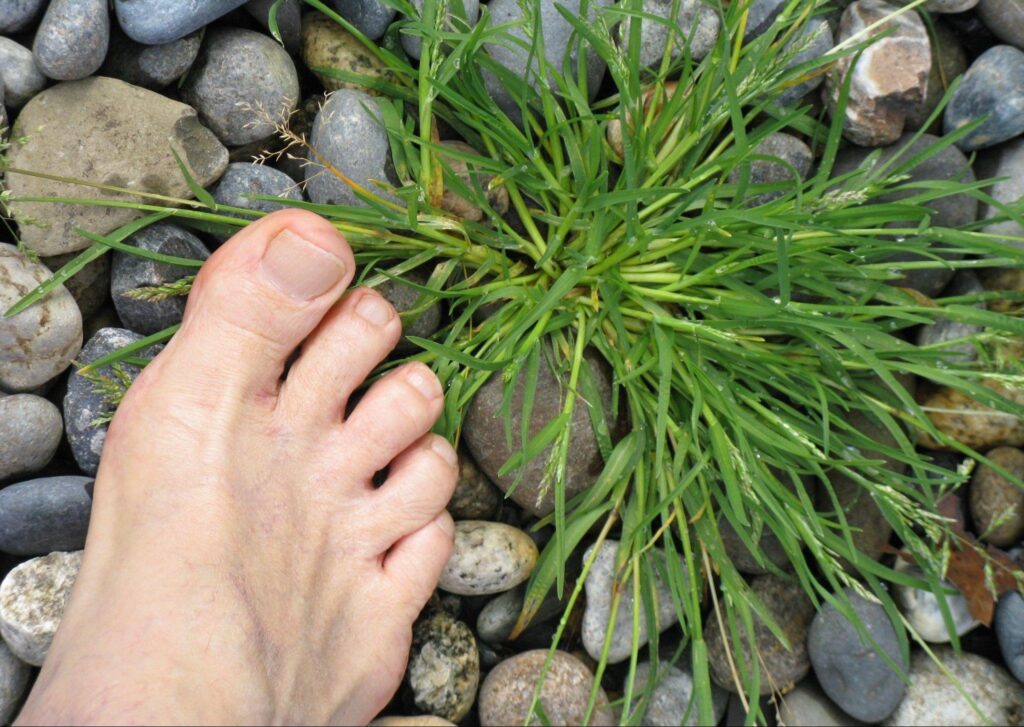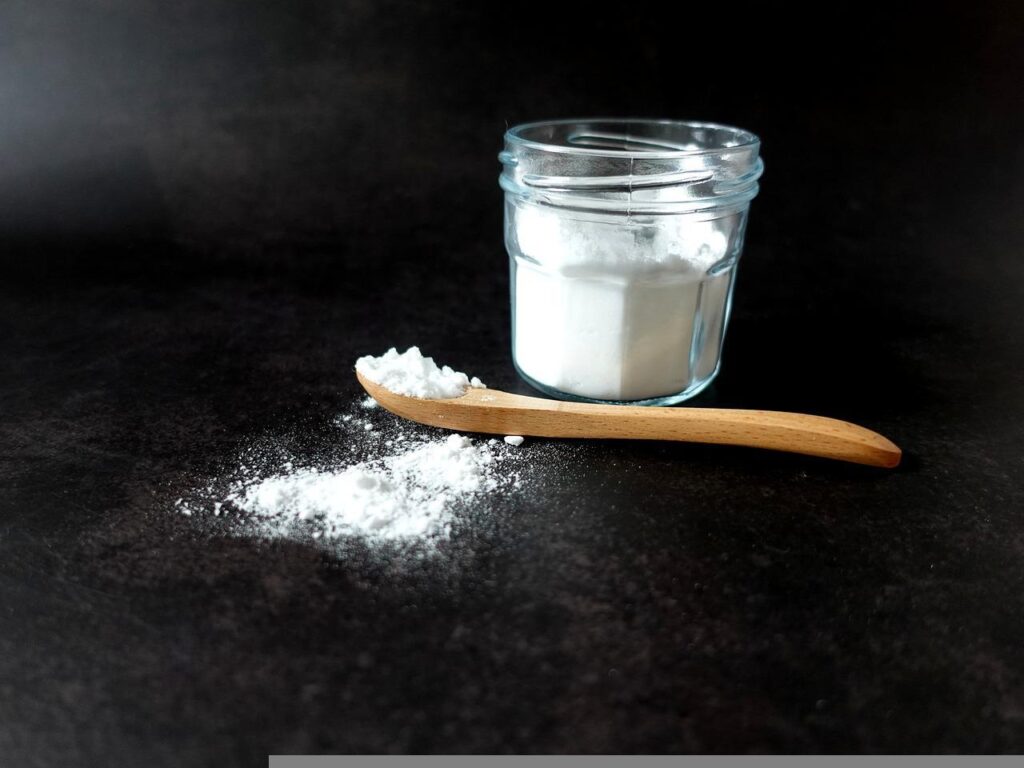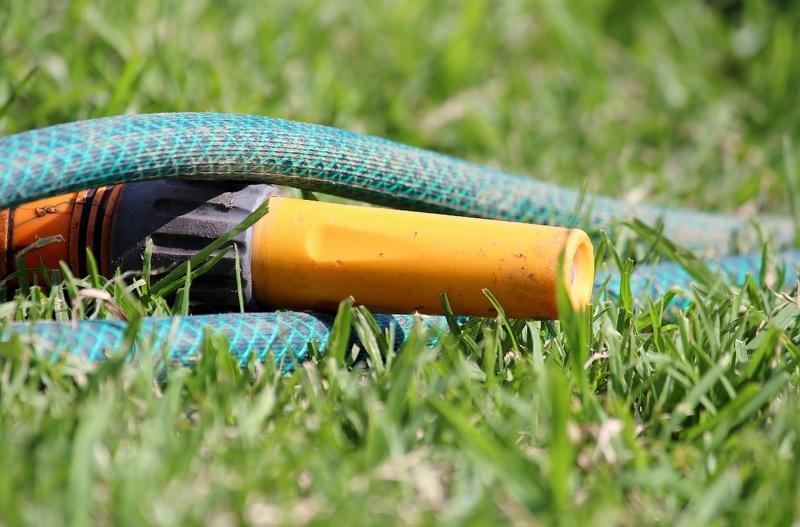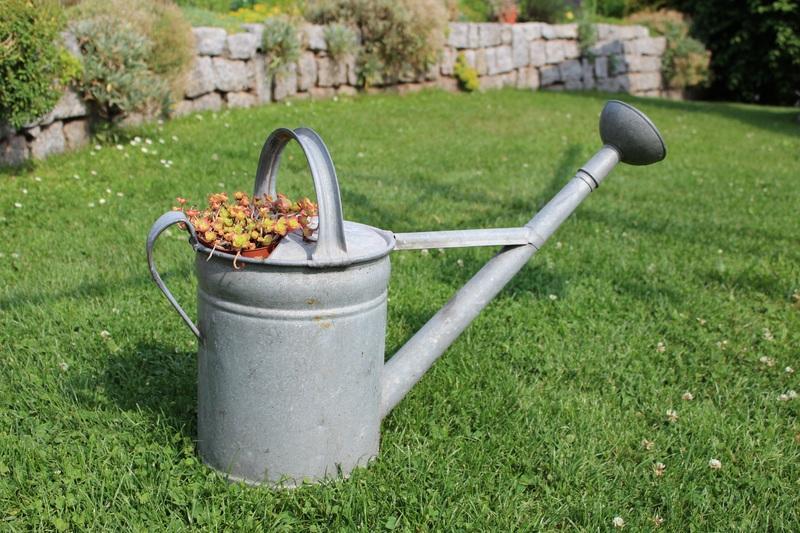Crab grass or crabgrass is a common term used to refer to a number of plants in the genus Digitaria. Some of these crabgrass plants are considered obnoxious lawn pests. These plants get their name because of their low-lying branchy growth habit. Like an ocean crab, crabgrass plants have a tough and rough texture with many legs (stems). In this article, let’s discuss about killing crabgrass with baking soda.

Crabgrass weeds are a common pest problem in Bermuda grass lawns and other turf areas.
Crabgrass is one of the most troublesome weeds in home lawns that are established using centipede grass, St. Augustine grass, Zoysia grass, and Bermuda grass. It spreads via seeds and a single plant can produce around 150,000 grass seeds in its life cycle. Crabgrass plants are hardy and once established, they can tolerate extreme weather and drought very well.
So, even if you spot only a few crabgrass plants on your Bermuda or Augustine lawn, you should not take it lightly. New weeds quickly emerge and fill up any bare spots on the lawn. If not controlled in time, these unwanted weeds can spread to the surrounding grass and promptly take over the entire lawn. Also, crabgrass competes aggressively with desired plants and other plants on the ground, eventually carrying them out.
So, if you are someone who is also dealing with a crabgrass infestation, you are in the right place. We will tell you everything you need to know about these pesky lawn weeds and how to kill crabgrass naturally using baking soda (sodium bicarbonate).
Crabgrass Quick Facts & Identification Guide
| Scientific Name | Digitaria |
| Other Names | Finger-grass, Fonio |
| Grass-Type | Monocotyledonous annual and perennial |
| Root System | – Complex and fibrous – Stretches nearly 4 feet in every direction |
| Leaves | Leaves are flat, wide, hairy, and lime green |
| Seeds | – Crabgrass seeds form in purplish seed heads – Seed germination is dependent on soil temperature |
| Stems | Stems are rolled and sprawling with purplish streaks |
| Growing Season | Early spring to late summer |
| Growth Habit | Prostrate growth habit forming large patches |
| Habitat | Prefers a heavy clay-loam soil with full or partial sun |
RELATED: Dallisgrass Vs. Crabgrass: Differences & How To Control Them | A Comprehensive Guide
How To Kill Crabgrass?

Baking soda kills crabgrass by removing water from the plant body.
The best way to control weeds, especially existing crabgrass, is to use a selective weed killer. Specific pre-emergent herbicides can also be used before the crabgrass appears on your lawn. However, some people avoid using chemical sprays as much as they can. This is because most chemical sprays often come with a plethora of negative side effects.
If you are one of those people, sodium bicarbonate is for you. Also known as baking soda, this crabgrass killer can help you get rid of crabgrass from your lawn permanently. So, how does baking soda kill grass? Baking soda or sodium bicarbonate works by removing water from the crabgrass. As a result, the crabgrass desiccates and dies.
You might need to spray sodium bicarbonate multiple times over your lawn to get rid of crabgrass permanently. For best results, target the young and actively growing plants that have not yet developed underground rhizomes. Here’s how you can do it:
Killing Crabgrass With Baking Soda
Wet The Crabgrass

A wet surface helps the baking soda stick to the plant.
Before you treat the crabgrass with baking soda, we suggest that you water the crabgrass using a sprinkler or garden hose. Water helps the sodium bicarbonate stick quickly with the plant surface, which increases the effectiveness of the baking soda treatment.
However, you might not need to water the crabgrass if you are treating the crabgrass with baking soda in the morning. It is because there might already be water on the surface of the leaf blades, which is enough to do the job.
Cover Surrounding Area
Next, you should cover the other grasses or the flower beds with cardboard or any other material that is safe to use. It is because baking soda is a non-selective crabgrass killer. If it comes in contact with any vegetation, it will kill it.
Sprinkle Baking Soda

Watering crabgrass after sprinkling baking soda can help kill its underground rhizomes.
Following that, you can sprinkle baking soda on the crabgrass. Once again, make sure that you have covered the other areas of the lawn properly. This nonspecific crabgrass killer will kill any plant it comes in contact with.
You might have to repeat this step after a few days depending on the extent of crabgrass infestation on your lawn. In addition to that, we suggest you water the lawn after sprinkling baking soda on it.
Let Baking Soda Kill Crabgrass
Once you have sprinkled the crabgrass with baking soda, it will start showing signs of desiccation in a few hours. At first, the grass will appear white because of the baking soda powder on its surface. Following that, you might also start to notice wilting leaves.
The wilting leaves then start to discolor and may appear black or brown. These signs confirm that your DIY crabgrass killer is working, and the crabgrass is dying. In a few days, you will notice that crabgrass is showing stunted growth.
Now you only need to apply the treatment once or twice more and give the baking soda enough time to work its magic on your lawn.
Remove Dead Crabgrass
Once crabgrass dies, you will have to move towards removing the dead crabgrass from your lawn. It is a must to ensure the complete eradication of the crabgrass from the lawn. If there are only a few weeds growing on your lawn, you can use your hands to do the job. However, if there are too many crabgrass weeds, you can make your job easy by using a weed puller.
Removing dead crabgrass is a vital step that will help prevent crabgrass from growing back on your lawn. It is because crabgrass has deep underground rhizomes that if not removed, can give rise to new grass very soon.
Fill In Bare Spots

Once you remove crabgrass, fill in the bare patches to prevent weeds from taking hold of your lawn.
Once you kill crabgrass with baking soda, there will be bare spots on your lawn. In addition to that, some holes might also develop on your lawn when you pull the weeds out of the ground. These will ruin the aesthetics of your beautiful lawn and green grass.
You can fill the bare spots by spreading seeds or planting plugs. After a while, new grass will start sprouting, and your lawn will be lush and green once again.
RELATED: Crabgrass Vs. Quackgrass | How To Tell The Difference & Which Is Worse?
Care For Your Lawn Properly
You can also apply topsoil over the bare patches which will increase the seed germination rate. In addition to that, you can also use a starter fertilizer to give the new grass a good head start. All in all, a proper lawn care plan is a must if you want your lawn to stay healthy and prevent crabgrass from coming back.
Other Homemade Crabgrass Killer Items
Baking soda on its own is an excellent crabgrass killer. However, you can increase its effectiveness and potency with simple household items such as cinnamon and vinegar. Here is how you can do it:
Baking Soda Mixed With Cinnamon
Cinnamon is known to have herbicidal properties both in its liquid form and powdered form that is available easily on the market. When mixed with baking soda, it becomes an even more potent weed killer that can help you kill crabgrass or any other lawn weeds in your yard. Here’s how you can make Cinnamon/Baking soda weed killer at home:
- Add half a cup of sodium bicarbonate to one gallon of water
- Following that, add one teaspoon of cinnamon oil or powder.
- Stir and mix the ingredients properly.
- Spot treat the crabgrass using a spray bottle on your lawn.
Usually, this treatment starts to show results within a few hours, and after a few rounds of spray, the weeds will completely die off within some days.
Baking Soda Mixed With Vinegar
Mixing baking soda vinegar is another excellent way of killing crabgrass on your lawn. Like baking soda, vinegar also works by desiccating the weeds. Vinegar contains acetic acid, not to be confused with citric acid, which gives it the power to kill the weeds.
In order to make a Vinegar/Baking soda weed killer, you can mix one part of baking soda with two parts of vinegar and mix it well. Then, put the mixture in a spray bottle and spot treat the weeds on your lawn. Repeat the treatment as many times as needed.
However, take care and not spray this potent weed killer on the surrounding plants. It will kill off the grass immediately and result in patchy brown turf.
Potential Side Effects
As already stated, baking soda is not selective in its action. It will kill off any vegetation that it comes in contact with. It means that you will risk damaging the grass on your lawn if you do not safely use the weed killer.
Moreover, since this is a salt, using too much of it can ruin the soil chemistry. For instance, if the amount of salt increases too much in the lawn soil, it can make it harder for the grass to uptake nutrients, minerals, and water.
Frequently Asked Questions (FAQs)
How long does it take for baking soda to kill crabgrass?
Once you apply the baking soda powder to the crabgrass, it will immediately pull water out of the plant tissue. In a few hours, you will start seeing signs of desiccation in the crabgrass. At first, the weeds will begin to wilt, followed by the discoloration of the leaf blades. Then, the crabgrass will completely dry out and die in a few days.
Is baking soda harmful to grass?
Baking soda kills crabgrass and other pesky weeds by drying them out. It is a reaction that is entirely nonspecific in nature and will affect weeds and grass alike. That is why baking soda can kill any vegetation, including the grass it touches. Moreover, it can also make it harder for some types of grass to grow back when applied to the lawn.
Will Baking Soda Kill Torpedo Grass?
Torpedo grass is a very hardy plant. It can withstand sudden and sharp changes in soil pH and chemistry very well. Moreover, torpedo grass has also developed resistance to many commercially available herbicides as well. So, to kill torpedo grass with baking soda, you will have to apply the treatment multiple times.
What will kill crabgrass but not grass?
If you only want to kill crabgrass on your lawn but not harm the grass in the process, you will have to use a selective weed killer. Baking soda, Vinegar, and other homemade weed killers are nonspecific in their action. Applying these on the lawn will also kill or damage other vegetation they come in contact with.
Will baking soda neutralize dog urine on grass?
Dog urine contains high amounts of nitrogen, which can kill crabgrass. Using baking soda will help neutralize the high concentration of nitrogen. In addition to that, it will also deodorize the area which will prevent the dog from going there again.
Sources For Further Reading
- Homemade herbicide considerations. College of Agricultural, Consumer & Environmental Sciences, University of Illinois. (2022). Retrieved 6 May 2022, from https://aces.illinois.edu/news/homemade-herbicide-considerations
- Homemade herbicides? Some thoughts about ‘Do It Yourself’ weed control. Agriculture and Natural Resources, University of California. (2022). Retrieved 6 May 2022, from https://ucanr.edu/blogs/blogcore/postdetail.cfm?postnum=14212
- Are There Home Remedies for Weed Control? Utah State University Extension Service. (2022). Retrieved 6 May 2022, from https://extension.usu.edu/archive/are-there-home-remedies-for-weed-control
Now that you know the proper way of killing crabgrass with baking soda, make sure to read our other articles:
How to Plant Bermuda Grass | Bermuda Grass Growth Stages and Care
Pros And Cons of Using Straw To Cover Grass Seed In A Newly Seeded Lawn







